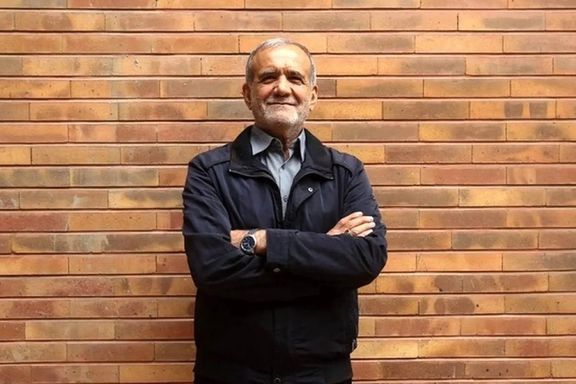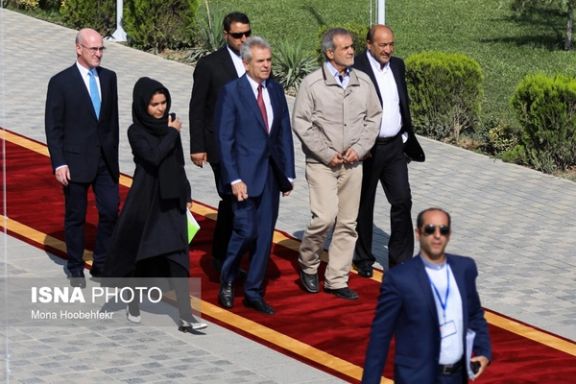Iran's new President criticized for ‘informal’ dress code

Newly-elected President Masoud Pezeshkian, who is frequently seen in public wearing casual zip-up jackets, is facing growing criticism for not “dressing up for the job.”

Newly-elected President Masoud Pezeshkian, who is frequently seen in public wearing casual zip-up jackets, is facing growing criticism for not “dressing up for the job.”
Prominent theater and cinema actor Reza Kianian was among the most vocal to chime in critically on Pezeshkian's dress code.
“I’d like to request you to wear a light summer suit jacket instead of that casual jacket,” Kianian said in an Instagram post addressed to the President on Sunday.
Since then, domestic Iranian news websites and social media users have extensively shared and republished the post.
Referring to former populist President Mahmoud Ahmadinejad, Kianian remarked that Iranians do not have “good memories” of the casual zip-up jacket (Kapshan in Persian) often associated with Ahmadinejad.
The jacket, which was a way to visually symbolize his anti-Western and anti-Israeli stance, remains a lasting image in many Iranians' minds.

“You must visit New York in a few months [to attend the UN General Assembly meeting]. What you wear is very important,” Kianian told Pezeshkian in his post, offered advice on clothing, socks, and shoes, and even recommended “a proper haircut”. “Let Iran be pictured befittingly [by foreign media at the event].”
Among the over 5,000 Instagram users who commented on Kianian’s post, many dismissively stated that Pezeshkian's style was inconsequential, arguing that more pressing issues deserved his attention.
Others agreed with Kianian, asserting that the new president should adhere to international dress protocols, at least while representing the country on the global stage.
Some of Pezeshkian's supporters on social media have argued that focusing on his attire at the UNGA meeting is irrelevant. They point out that Arab leaders, as well as Indians, Malaysians, and others, often wear traditional robes and flip-flops at such events. They contend that what truly matters is what Pezeshkian has to offer the world.
Pezeshkian, a heart surgeon and lawmaker who was relatively unknown to many Iranians before the snap elections following former President Ebrahim Raisi's death in a helicopter crash in May, has occasionally mentioned that he finds it challenging to adhere to the strict protocols required of the president. He has also expressed that he would like to continue living like an "ordinary Iranian" and to be true to himself.

Social media posts and media articles dating back to August 2016, when Pezeshkian was the Deputy Speaker of Parliament, criticized his disregard for diplomatic dress codes and norms during the inauguration ceremony of President Hassan Rouhani, particularly in how he welcomed foreign delegations.
“Not observing official protocols, sneaking into Parliament unannounced [on Saturday], shopping at your local grocery store, and wearing a jacket in the middle of the summer is not a sign of being a man of the people and a revolutionary. It is a sign that you are another version of Ahmadinejad,” another critic posted on X.
Ahmadinejad, whose supporters took his badly worn zip-up jackets and windbreakers as a sign that he was “a man of the people,” began wearing formal suits regularly after a few years.
In recent years, the former President has undergone several superficial changes alongside his supposed shifts in worldview. Ahmadinejad has reportedly undergone cosmetic procedures to reduce the deep wrinkles around his eyes and mouth, aiming to project a new image that appeals to fashion-conscious middle-class Iranians.
Following the Islamic Revolution of 1979, wearing ties became a symbol of Western cultural adherence, which young revolutionaries like Pezeshkian strongly denounced as 'un-Islamic.' Consequently, an unofficial ban was imposed on selling and wearing ties.
Subsequently, wearing a tie became a subliminal statement of opposition to the clerical regime among professional Iranians, including doctors, lawyers, and wealthy businessmen.
The male revolutionaries also disapproved of wearing collared shirts. In response, the Iranian foreign ministry designed collarless shirts for its diplomats, resembling the garments clerics wear under their robes.
Some diplomats, such as former Foreign Minister Javad Zarif, style these mandatory collarless shirts with expensive cufflinks.
Fashion awareness appears to be important among clerics, too.
The former "reformist" President Mohammad Khatami, frequently dubbed “the man in the chocolate-brown robe” by Iranian media for one of his robes, was often praised for his “impeccable style.” The "moderate" former President Hassan Rouhani was known for wearing robes reportedly made from expensive Italian fabrics.